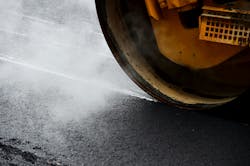By Joseph Shacat, Contributing Author
At 2 p.m. on March 26, the author will present a lecture, “EPDs, Everything You Wanted to Know about Environmental Product Declarations But Were Afraid to Ask,” at the World of Asphalt Show and Conference in Nashville, Tenn.
Low-bid procurement is a mainstay of the asphalt paving industry, but there is a growing movement among public and private owners alike to adopt low-carbon procurement policies (aka Buy Clean policies).
We have seen a rapid acceleration in the adoption of Buy Clean policies thanks to new funding authorized under the Inflation Reduction Act (IRA) and other federal programs.
Buy Clean is a catch-all phrase for policies that focus on reducing the embodied greenhouse gas emissions associated with construction products and materials. While there are many variations of Buy Clean policies, here are the common traits that these policies share:
- They generally rely on environmental product declarations (EPDs) to quantify the embodied carbon emissions associated with manufacturing construction products and materials.
- The information in EPDs will be used to inform decision making related to pavement design, procurement, and/or maintenance activities.
For public agencies, Buy Clean policies can be driven by legislative mandate (e.g., Colorado, Oregon, and Minnesota), executive order (New York), or direct agency action (Pennsylvania, Delaware, and Maryland).
Local agencies have taken a bite at the apple as well, with the most notable example being the Port Authority of New York and New Jersey. State and local agencies are supported by a variety of federal programs focused on EPDs and embodied carbon, including the Federal-State Buy Clean Partnership1, the Federal Highway Administration (FHWA) Climate Challenge2, and the Every Day Counts (EDC) EPDs for Sustainable Project Delivery initiative.
While these programs focus primarily on education, training, and information exchange, they don’t provide funding for agencies to adopt Buy Clean policies. That’s where the IRA comes into play.
Buy Clean and the IRA
Under the IRA, $4.5 billion is earmarked for programs that will advance low-carbon procurement policies. This includes:
- $250 million for the EPA to standardize EPDs and assist industry with developing EPDs.
- $100 million for the EPA to establish a low-embodied carbon labeling program for construction products and materials.
- $2 billion to FHWA, who will provide grants to federal, state, and local agencies to cover the differential cost or an incentive for purchasing low-carbon construction products and materials.
- $2.15 billion to the General Services Administration (GSA) to cover the differential cost or an incentive for purchasing low carbon construction products and materials.
Of these, the most salient for paving contractors is FHWA’s $2 billion Low-Carbon Transportation Materials Grants program.
These grants will be available for agencies that use low-carbon materials for federal-aid highways and federal lands transportation facilities, among other eligible roadways. Federal-aid highways are a 3.9-million-mile network that includes the Interstate Highway System, primary highways, and secondary local roads.
The GSA’s $2.15 billion program also has significant implications for the asphalt paving industry, affecting paving projects at land ports of entry (at the borders to Canada and Mexico), federal office buildings, and federal courthouses across the country. The GSA has identified over 150 low-embodied carbon projects, of which 82 are expected to use low-carbon asphalt.
Additional federal spending for low-carbon construction materials is authorized under similar IRA provisions for the Federal Emergency Management Agency (FEMA) and the Department of Housing and Urban Development (HUD).
Qualifying as low carbon
For purposes of the FHWA grant program, the IRA states that construction products and materials must have “substantially lower levels of embodied greenhouse gas emissions… as compared to estimated industry averages of similar materials or products” as determined by the EPA.
In December 2022, the EPA issued an Interim Determination that defines a cascading set of thresholds. The first threshold is the best-performing (lowest embodied carbon) 20th percentile when compared to similar products or materials.
If those aren’t locally available, the next threshold is the best-performing 40th percentile. If no such products are locally available, the final tier is for products that are better than the estimated industry average.
The EPA requires EPDs to be used to determine a product’s embodied carbon emissions. Estimated industry averages, on the other hand, will be determined by the implementing agencies (GSA and FHWA). We’ll explore the GSA’s approach first, followed by FHWA’s.
GSA Low-Embodied Carbon Program
In May 2023, GSA released its Interim IRA Low Embodied Carbon Material Requirements. The agency determined its thresholds based on published EPDs that had been uploaded into an independent database known as EC3.
The GSA had an urgent need to publish embodied carbon limits quickly because they have a shorter timeframe to draw down the available IRA funds than FHWA.
|
GSA IRA Limits for Low Embodied Carbon Asphalt (kg CO2e/metric tonne of asphalt mixture) |
||
|
Top 20% Limit |
Top 40% Limit |
Better Than Average Limit |
|
55.4 |
64.8 |
72.6 |
Unfortunately, the GSA limits for asphalt mixtures are not subdivided by mix type, agency specification requirements, or on a geographical basis. While this is not ideal, NAPA has a good working relationship with the agency, which is open to considering more robust approaches as they become available.
GSA construction projects typically operate on a best-value procurement system in which contractors are awarded points based on criteria identified in the project solicitation. For their low-embodied carbon projects, contractors are also awarded points based on their ability to source construction materials that meet the GSA’s embodied carbon limits.
The higher the threshold achieved (lower embodied carbon), the more points they are awarded. Thus, the GSA is incentivizing contractors to source low-carbon materials during the pre-bid phase.
Building a Better Industry Average
Ideally, agencies would collect EPDs for all relevant mix types over a period of several years to establish mix type-specific, agency-specific industry averages.
This approach is not feasible within the relatively short timeframe provided in the IRA. In February 2023, NAPA hosted a low-carbon asphalt workshop to develop a better approach to defining asphalt mixture industry averages for IRA implementation.
About 30 industry stakeholders locked themselves in a room for two days with representatives from the EPA and FHWA. Together, we developed a framework by which mix type-specific regional industry averages can be estimated based on a combination of industry data and analysis of agency specifications.
NAPA launched its first industry average benchmarking initiative in May 2023 and collected data from more than 300 asphalt plants. The initial benchmarking report will be published this month, and FHWA has committed to using NAPA’s benchmarking approach as the basis for its Low-Carbon Transportation Materials Grants Program.
In the meantime, NAPA has re-opened data collection for the industry average benchmarking initiative and will update the benchmarking report later this year.
Additional details about FHWA’s grant program are scant (at the time of writing this article, the program requirements not yet been released), but we know the program will move quickly once it rolls out since the funds must be obligated by September 2026.
And with funding available to state and local agencies alike, paving contractors in many jurisdictions across the country can expect to see low-carbon procurement coming their way in the next couple of years.
How to prepare for low-carbon procurement
The first thing an asphalt mix producer can do to prepare for low-carbon procurement is to participate in NAPA’s benchmarking initiative.
The more plants that participate, the more representative (and fair) the industry averages will be for everyone. There is no cost to participate, and you don’t even have to be a NAPA member to submit benchmarking data.
The second thing a company should do is to develop EPDs for at least one of their asphalt plants. NAPA’s Emerald Eco-Label software tool makes this process easy and cost effective.
By developing EPDs, companies will understand how plant operations and mix designs affect EPD results. With the integrated optimizer tool, companies can then develop plans to reduce carbon emissions while also reducing mix production costs.
NAPA’s The Road Forward program has a host of resources available for mix producers to learn how to reduce emissions through the use of recycled materials and implementing energy efficiency measures.
Another great resource is the ENERGY STAR APEX program, a peer exchange group that provides information and guidance for asphalt mix producers to manage and reduce energy consumption, with opportunities to formally recognize companies for their achievements toward reducing energy consumption.
I have worked with dozens of companies who have started down the path of developing EPDs and managing energy. Almost universally, they have learned that reducing emissions is cost effective, meaning that they can be more competitive while they prepare for low-carbon procurement. Indeed, the future is bright for those who go into this process with an open mind and a willingness to do things a little differently. RB
By Joseph Shacat is director of sustainable pavements at the National Asphalt Pavement Association (NAPA).



